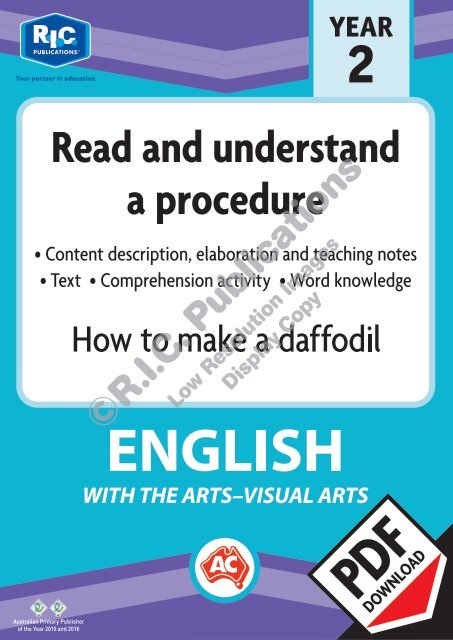RIC-30038_How_to_make_a_daffodil_Read_and_understand_a_procedure
You also want an ePaper? Increase the reach of your titles
YUMPU automatically turns print PDFs into web optimized ePapers that Google loves.
©R.I.C. Publications<br />
Low Resolution Images<br />
Display Copy
<strong>How</strong> <strong>to</strong> <strong>make</strong> a <strong>daffodil</strong><br />
• • • • • • • • • • • • • • • • • • • •<br />
Teacher information<br />
Curriculum links<br />
J<br />
Activity Content description Elaboration<br />
Text • Know some features of text organisation including page <strong>and</strong> screen layouts, alphabetical • Uses diagrams <strong>to</strong> support text underst<strong>and</strong>ing<br />
order, <strong>and</strong> different types of diagrams, for example timelines (ACELA1466) O<br />
• <strong>Read</strong>s a <strong>procedure</strong><br />
• Recognises language features of procedural<br />
• Underst<strong>and</strong> that different types of texts have identifiable text structures <strong>and</strong> language<br />
text<br />
features that help the text serve its purpose (ACB.A1463) O<br />
Comprehension • Underst<strong>and</strong> the use of vocabulary about familiar <strong>and</strong> new <strong>to</strong>pics <strong>and</strong> experiment with • Identifies subject-specific vocabulary<br />
<strong>and</strong> begin <strong>to</strong> <strong>make</strong> conscious choices of vocabulary <strong>to</strong> suit audience <strong>and</strong> purpose • Comprehends informational text<br />
(ACE1A1470) 0<br />
• <strong>Read</strong>s step in a <strong>procedure</strong><br />
• <strong>Read</strong> less predictable texts with phrasing <strong>and</strong> fluency by combining contextual, semantic,<br />
grammatical <strong>and</strong> phonic knowledge using text processing strategies, for example<br />
moni<strong>to</strong>ring meaning, predicting, re-reading <strong>and</strong> self-correcting (ACELY1669) 0<br />
• Use comprehension strategies <strong>to</strong> build literal <strong>and</strong> inferred meaning <strong>and</strong> begin <strong>to</strong> analyse<br />
texts by drawing on growing knowledge of context, language <strong>and</strong> visual features <strong>and</strong> print<br />
<strong>and</strong> multimodal text structures (ACELY1670) O<br />
• Compare opinions about characters, events <strong>and</strong> settings in <strong>and</strong> between texts<br />
(ACELT1589) 0<br />
Word knowledge • Orally manipulate more complex sounds in spoken words through knowledge of blending • Adds suffixes<br />
<strong>and</strong> segmenting sounds, phoneme deletion <strong>and</strong> substitution in combination with use of • Choose different digraphs <strong>to</strong> represent the 'I'<br />
letters in reading <strong>and</strong> writing (ACB.A1474) O<br />
sound<br />
• Identifies comm<strong>and</strong> verbs<br />
• Recognise common prefixes <strong>and</strong> suffixes <strong>and</strong> how they change a word's meaning<br />
• Syllabifies words<br />
(ACE1A1472) 0<br />
• Underst<strong>and</strong> how <strong>to</strong> use knowledge of digraphs, long vowels, blends <strong>and</strong> silent letters <strong>to</strong><br />
spell one <strong>and</strong> two syllable words including some compound words (ACELA1471) O<br />
'-<br />
Additional teacher<br />
information<br />
• Underst<strong>and</strong> that a sound can be represented by various letter combinations<br />
(ACE1A1825) e<br />
Definition of terms<br />
Procedur<br />
Procedures tell how <strong>to</strong> <strong>make</strong> or do something. They use clear,<br />
concise language <strong>and</strong> comm<strong>and</strong> verbs. A list of materials required <strong>to</strong><br />
complete the <strong>procedure</strong> is included <strong>and</strong> the instructions are set out<br />
in easy-<strong>to</strong>-follow steps.<br />
Text<br />
A book or other written or printed work, regarded in terms of its<br />
content rather than its physical form.<br />
Terminology for students<br />
<strong>procedure</strong><br />
instruction<br />
©R.I.C. Publications<br />
Low Resolution Images<br />
Display Copy<br />
word<br />
step<br />
syllable<br />
sentence<br />
suffix<br />
base word<br />
Links <strong>to</strong> other curriculum areas<br />
• The Arts - Visual Arts<br />
- Use <strong>and</strong> experiment with different materials, techniques,<br />
technologies <strong>and</strong> processes <strong>to</strong> <strong>make</strong> artworks (ACAVAM1011 O<br />
Suggested reading<br />
• From bulb <strong>to</strong> <strong>daffodil</strong> (Scholastic News non-fiction readers) by<br />
Ellen Weiss<br />
• Daffodil by Emily Jenkins<br />
1 • • • • • • • Developing comprehension skills <strong>and</strong> word knowledge (Year 2) • • • • • • • R.I.C. Publications ® · • • • • • • www.ricpublications.com.au
Teaching notes<br />
J<br />
Text<br />
Comprehension<br />
Teacher information<br />
• Information can be relayed in many ways including the use of diagrams.<br />
Introduction<br />
Teacher information<br />
• Students might need a dictionary <strong>to</strong> complete Question 1.<br />
Introduction<br />
• Teachers should show students a <strong>daffodil</strong> <strong>and</strong> explain that this flower is the<br />
national flower of Wales. They should explain that <strong>daffodil</strong>s are traditionally<br />
worn by Welsh people on St David's Day (1 March).<br />
Development<br />
• <strong>Read</strong> <strong>and</strong> discuss the <strong>procedure</strong> with students <strong>to</strong> gauge their underst<strong>and</strong>ing<br />
of what they have listened <strong>to</strong> or read. Encourage them <strong>to</strong> use phonic<br />
knowledge <strong>and</strong> skills, <strong>and</strong> contextual information while reading. Correct<br />
inaccuracies during reading <strong>and</strong> question students <strong>to</strong> ensure they are<br />
making sense of the text. Highlight common exception words so they<br />
become more familiar with them, which will aid fluency. While reading,<br />
observe how students use phonic skills <strong>and</strong> knowledge <strong>to</strong> decode words.<br />
Assist those having difficulty.<br />
• During discussion of the <strong>procedure</strong>, encourage students <strong>to</strong> employ courteous<br />
listening skills such as turn-taking <strong>and</strong> listening <strong>to</strong> the points of view of<br />
others. Students may like <strong>to</strong> compare the <strong>procedure</strong> <strong>to</strong> others they have read<br />
or listened <strong>to</strong>.<br />
• Discuss the meaning of any new or unfamiliar words <strong>and</strong> phrases. Some<br />
vocabulary is subject-specific relating <strong>to</strong> art <strong>and</strong> craft activities.<br />
• Discuss the layout of the <strong>procedure</strong>/instructions with students so they can<br />
see how numbered, concise steps <strong>make</strong> it easier <strong>to</strong> follow the instructions.<br />
The instructions usually begin with an imperative (comm<strong>and</strong>) verb.<br />
Differentiated individual/paired/group work<br />
• Students write a <strong>procedure</strong> for completing an everyday household chore;<br />
for example, washing up a cup, emptying the bin, dusting <strong>and</strong> polishing an<br />
ornament.<br />
• Less capable students could work in pairs <strong>to</strong> write their instructions.<br />
• More capable students need <strong>to</strong> have at least five steps in their task.<br />
Review<br />
• Students should read their instructions <strong>to</strong> their group as the students act<br />
them out. <strong>How</strong> well-written do students think these instructions are?<br />
• Discuss the structure of the instructions. Talk about why<br />
the 'You will need' section is useful, <strong>and</strong> why these things<br />
need <strong>to</strong> be collected before making the <strong>daffodil</strong>s. Discuss<br />
why the instructions are written in steps. Why do students<br />
think some of the steps have illustrations? <strong>How</strong> do these<br />
help?<br />
Development<br />
• Remind students how <strong>to</strong> use a dictionary efficiently;<br />
i.e. alphabetical order <strong>and</strong> retrieval by 1st, 2nd <strong>and</strong> 3rd<br />
letters. Give each student, or pair of students, a dictionary.<br />
Write words from the text on<strong>to</strong> the board for students <strong>to</strong><br />
find.<br />
• If the student's answer <strong>to</strong> Question 8 on page 104 is<br />
'No', ask them <strong>to</strong> explain why. Discussion may elicit the<br />
response that a particular piece of information would have<br />
helped <strong>make</strong> the text easier for that reader <strong>to</strong> underst<strong>and</strong>.<br />
Discuss in relation <strong>to</strong> the diagrams. Would the text have<br />
been unders<strong>to</strong>od without the diagrams?<br />
• Discuss the comprehension activities on page 104, then<br />
allow students <strong>to</strong> complete the page independently.<br />
Differentiated individual/paired/group work<br />
• Ask students <strong>to</strong> illustrate the steps where they were not<br />
provided in the text.<br />
• In pairs, or individually, have students attempt <strong>to</strong> <strong>make</strong> the<br />
<strong>daffodil</strong>s by following the instructions.<br />
©R.I.C. Publications<br />
Low Resolution Images<br />
Display Copy<br />
Review<br />
• Discuss whether any of the steps were difficult <strong>to</strong><br />
illustrate. Why was this?<br />
• When the students were following the instructions <strong>to</strong><br />
<strong>make</strong> the <strong>daffodil</strong>s, were there any that caused confusion?<br />
Which ones? <strong>How</strong> would they improve the wording of<br />
these confusing instructions?<br />
R.I.C. Publications ® • • • • • • • www.ricpublications.com.au • • • • • • • Developing comprehension skills <strong>and</strong> word knowledge (Year 2) • • • • • • • 2
Teaching notes<br />
(continued)<br />
Answers<br />
J<br />
Teacher information<br />
Word knowledge<br />
• The activities on page 105 focus on syllables <strong>and</strong> a range of suffixes.<br />
Introduction<br />
• Re-read the text, but first explain <strong>to</strong> students that the focus will be on words.<br />
While reading the 'Steps', ask them <strong>to</strong> underline the first word in each step.<br />
Explain that these are comm<strong>and</strong> or imperative verbs giving instructions.<br />
Development<br />
• The 'ii', 'al' <strong>and</strong> 'le' words in Question 2 should be pronounced clearly so<br />
students can hear the specific phonemes.<br />
• Explain that the /1/ sound at the end of words has several spellings. The 'le'<br />
spelling is the most common; for example, apple, table. The 'el' spelling is<br />
used after 'm', 'n', 'r', 's', 'v', 'w' <strong>and</strong> sometimes 's'; for example, travel, <strong>to</strong>wel.<br />
Other spellings are 'al' (animal, metal) <strong>and</strong> 'ii' (pencil, nostril).<br />
• Discuss <strong>and</strong> list words which end with the suffix '-ing'. Tell students that this<br />
suffix is used <strong>to</strong> express the action of a verb. Tell them that it is usually added<br />
<strong>to</strong> the end of base words without any spelling change; e.g. feeding. <strong>How</strong>ever,<br />
base words ending in 'e' need <strong>to</strong> drop the 'e' before adding the suffix; e.g.<br />
having, coming.<br />
• Discuss <strong>and</strong> list words which end with the suffix '-ly'. Tell students that words<br />
ending in '-ly' usually tell how or how often something is done. Explain that<br />
the suffix is usually added <strong>to</strong> the end of most base words without any spelling<br />
change; e.g. hourly, sadly. <strong>How</strong>ever base words ending in 'y' with a consonant<br />
before it will need a spelling change; e.g. day/daily, happy/happily.<br />
• Discuss the word knowledge activities on page 105, then allow students <strong>to</strong><br />
complete the page independently.<br />
Differentiated individual/paired/group work<br />
• In pairs, students should find <strong>and</strong> list words with an '-ly' suffix.<br />
• More capable students should aim <strong>to</strong> create a longer list than less capable<br />
students.<br />
Review<br />
1<br />
-ly' suffix 1<br />
-ly' suffix<br />
(Added <strong>to</strong> end of base word)<br />
carefully<br />
kindly<br />
badly<br />
• Compare students' lists of '-ly' words.<br />
(The 'y' changes <strong>to</strong> 'i' before<br />
adding '-ly')<br />
happily<br />
merrily<br />
prettily<br />
Comprehension<br />
1. (a) instructions - directions or orders; steps<br />
(b) half - one of two equal parts<br />
(c) petal - coloured segments of a flower<br />
(d) marker - a felt-tip pen with a broad tip<br />
(e) straw - a hollow tube for sucking up liquid<br />
2. the stem<br />
3. Fold the square in half.<br />
4. Roll the petals around the marker over the first sheet<br />
of paper.<br />
5. Display in an empty vase with others.<br />
6. Tissue paper is soft <strong>and</strong> light (it <strong>make</strong>s it easy <strong>to</strong> fold).<br />
7. The water will wet <strong>and</strong> destroy the paper.<br />
8.-9. Answers will vary.<br />
Wont knowledge<br />
1. (a) tissue, marker, display, flower, paper, scissors,<br />
upright, between, gently<br />
(b) <strong>daffodil</strong>, similar, national, instructions, rectangle,<br />
carefully<br />
2. (a) <strong>daffodil</strong>, petal, rectangle<br />
(b) Teacher check<br />
3. (a) making, hanging, holding<br />
(b) e<br />
(c) gently, carefully<br />
(d) e<br />
4. (a) -ing, -er<br />
(b) -ing, -ed, -er<br />
(c) -ing, -ed, -er<br />
©R.I.C. Publications<br />
Low Resolution Images<br />
Display Copy<br />
3 • • • • • • • Developing comprehension skills <strong>and</strong> wont knowledge (Year 2) • • • • • • • R.I.C. Publications ® · • • • • • • www.ricpublications.com.au
<strong>How</strong> <strong>to</strong> <strong>make</strong> a <strong>daffodil</strong> - 1<br />
<strong>Read</strong> the instructions for making a tissue paper <strong>daffodil</strong>.<br />
Step 3<br />
You will need:<br />
• strong glue • scissors<br />
• yellow tissue paper • green 'bendy' straw<br />
• thick marker or round object of similar width<br />
Steps:<br />
1. Cut tissue paper in<strong>to</strong> square (13 cm x 13 cm).<br />
2. Fold square in half <strong>and</strong> cut along fold <strong>to</strong> <strong>make</strong> two<br />
rectangles.<br />
3. Take one rectangle <strong>and</strong> roll paper around one end of<br />
marker. (About half of paper should hang over.)<br />
4. Twist paper hanging over end of marker.<br />
5. Take other rectangle, fold in half <strong>and</strong> then fold in half<br />
again.<br />
6. Holding folded rectangle upright, cut petal shape.<br />
7. Unfold <strong>and</strong> <strong>make</strong> a small cut between each petal.<br />
8. Roll petals around marker over first sheet of paper.<br />
Twist ends around marker again.<br />
9. Cut off short end of 'bendy' straw.<br />
10. Drop glue on<strong>to</strong> inside of straw <strong>and</strong> gently push in<br />
flower. Allow <strong>to</strong> dry.<br />
11. Slide marker carefully out.<br />
12. Bend straw down <strong>and</strong> gently fold out each petal.<br />
13. Display in an empty vase with others.<br />
©R.I.C. Publications<br />
Low Resolution Images<br />
Display Copy<br />
Step 4<br />
Step 6<br />
<strong>How</strong> did you do?<br />
Do you think you could follow the instructions <strong>to</strong> <strong>make</strong><br />
<strong>daffodil</strong>s?<br />
When I read this <strong>procedure</strong>, I could read:<br />
My learning log<br />
all of it.<br />
most of it.<br />
parts of it.<br />
R.I.C. Publications ® • • • • • • • www.ricpublications.com.au • • • • • • • Developing comprehension skills <strong>and</strong> word knowledge (Year 2) • • • • • • • 4
<strong>How</strong> <strong>to</strong> <strong>make</strong> a <strong>daffodil</strong> - 2<br />
Comprehension<br />
1. Match each word <strong>to</strong> its meaning.<br />
(a) instructions • • coloured segments of a flower<br />
(b) half • • a hollow tube for sucking up liquid<br />
(c) petal • • directions or orders; steps<br />
(d) marker • • one of two equal parts<br />
(e) straw • • a felt-tip pen with a broad tip<br />
2. What part of the <strong>daffodil</strong> is the 'bendy' straw? ___________<br />
3. What must you do <strong>to</strong> the tissue paper just before cutting two rectangles?<br />
4. What must you do right after making small cuts between each petal?<br />
5. What is the last step in the <strong>procedure</strong>?<br />
6. What sort of paper is tissue paper? Is it stiff <strong>and</strong> hard or soft <strong>and</strong> light?<br />
7. Why does the vase need <strong>to</strong> be empty of water?<br />
©R.I.C. Publications<br />
Low Resolution Images<br />
Display Copy<br />
8. Are the instructions clear enough that you think you could easily <strong>make</strong> a<br />
<strong>daffodil</strong>? L Yes)-------------------<br />
9. What other craft objects have you made using paper?<br />
My learning log<br />
While doing these activities:<br />
I found a __ easy.<br />
I<br />
I found a __ tricky.<br />
I<br />
I found a __ fun.<br />
5 • • • • • • • Developing comprehension skills <strong>and</strong> word knowledge (Year 2) • • • • • • • R.I.C. Publications ® · • • • • • • www.ricpublications.com.au
<strong>How</strong> <strong>to</strong> <strong>make</strong> a <strong>daffodil</strong> - 3<br />
Word knowledge<br />
1. (a) Circle the words with two syllables.<br />
(b) Underline the words with three syllables.<br />
<strong>daffodil</strong><br />
display<br />
paper<br />
between<br />
tissue<br />
flower<br />
scissors<br />
gently<br />
similar<br />
national<br />
rectangle<br />
carefully<br />
marker<br />
instructions<br />
upright<br />
2. (a) Find <strong>and</strong> write words in the text with the following endings.<br />
-ii-------- -al ________ -le ________<br />
(b) Write a sentence using two of these words.<br />
3. (a) Find <strong>and</strong> write three words in the text with the suffix '-ing'.<br />
(b) One of these words dropped a letter before adding '-ing'.<br />
Which letter? ___<br />
(c)<br />
(d)<br />
Find <strong>and</strong> write two words in the text with the suffix '-ly'.<br />
©R.I.C. Publications<br />
Low Resolution Images<br />
Display Copy<br />
One of these words dropped a letter before<br />
adding '-ly'. Which letter? ___<br />
4. Tick the suffixes that can be added <strong>to</strong> the following base words.<br />
(a) read O-ing O-ed O-er<br />
(b)<br />
twist<br />
O-ing<br />
0-ed<br />
0-er<br />
(c)<br />
fold<br />
O-ing<br />
0-ed<br />
0-er<br />
My learning log<br />
Write Yes or No.<br />
I can count syllables in different words. ________<br />
I can recognise words ending in '-ii', '-al' <strong>and</strong> '-le'. ________<br />
I can add suffixes <strong>to</strong> base words. ________<br />
R.I.C. Publications ® • • • • • • • www.ricpublications.com.au • • • • • • • Developing comprehension skills <strong>and</strong> word knowledge (Year 2) • • • • • • • 6


















